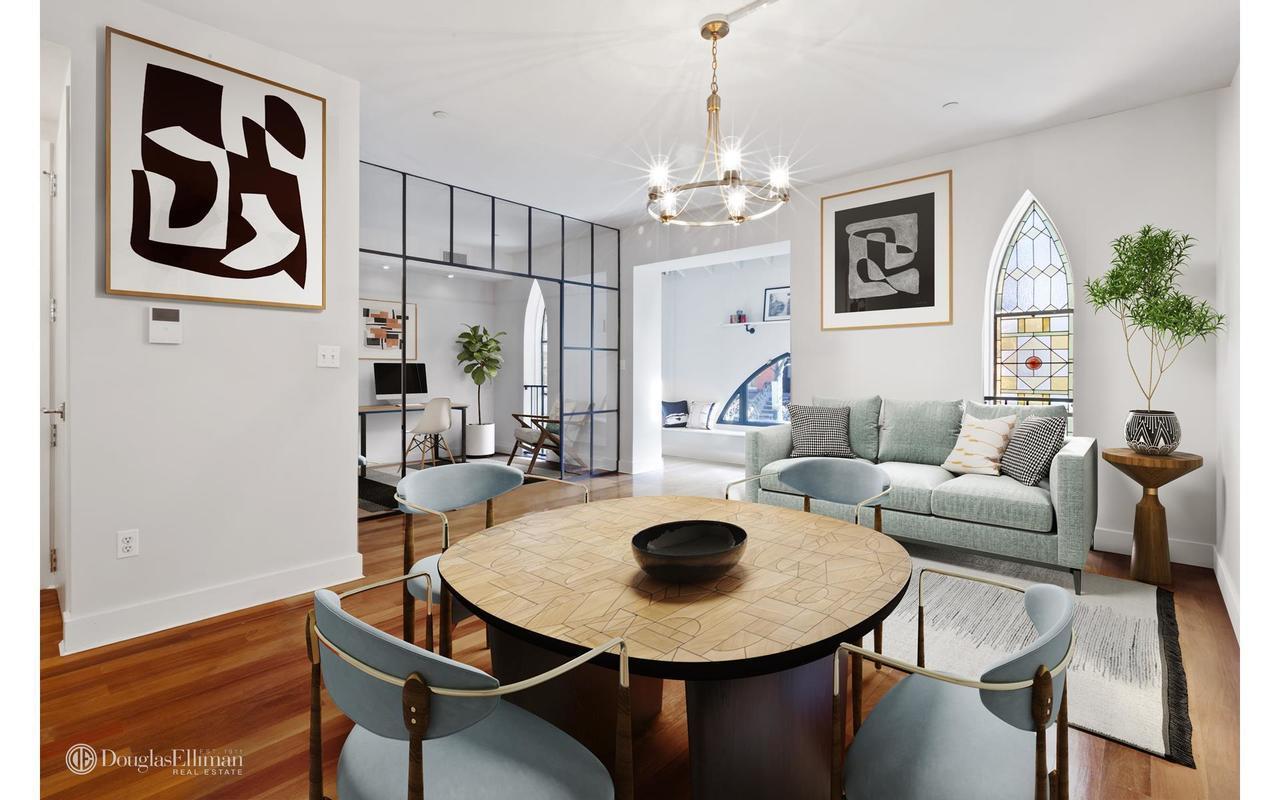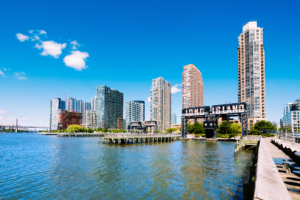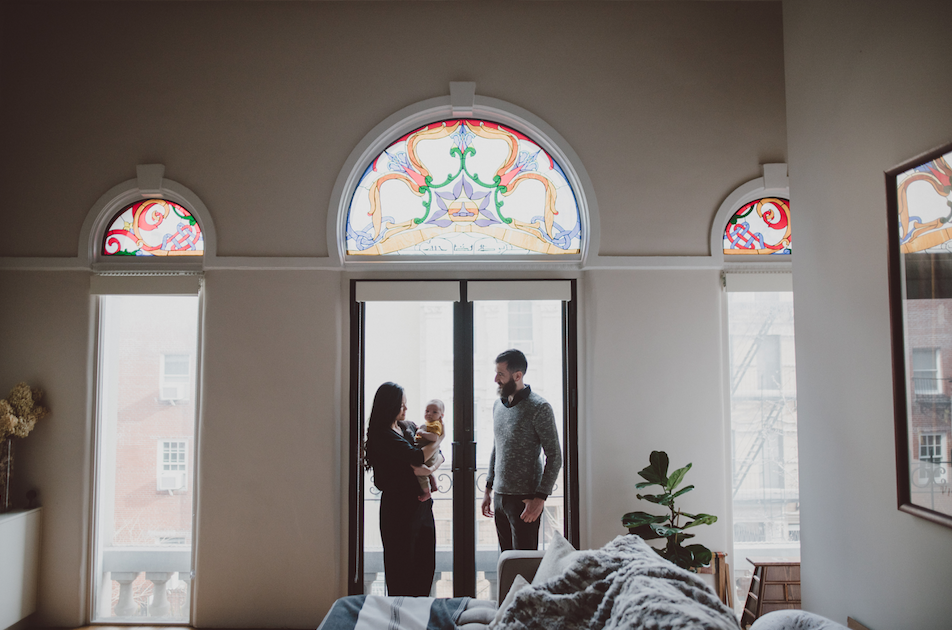
David and Danielle Trencher with their son, Mack, in the living room of their apartment in a former Alphabet City synagogue. The building is on the same block of East 7th Street where Trencher’s great-grandfather grew up. (Photo courtesy LOVE + WOLVES CO)
With changes in demographics and a decrease in religious observance in parts of New York City, former houses of worship across the city are being converted into residential apartments.
While this concept isn’t brand new — some of the first conversions happened more than 20 years ago — these repurposed homes are still quite rare. So we spoke with homeowners and real estate agents about what it’s really like to sell and dwell in these former houses of God.
“Some people are weirded out by this scenario,” says Scott Harris, a real estate broker at Brown Harris Stevens. “Some buyers actually don’t even like to look out onto houses of worship.”
But “there’s a lid for every pot,” Harris says, and it turns out that many New Yorkers are delighted to be living in a former church or synagogue — or at least very close to one.
‘Serenity and Tranquility in the City’
“I think most people love the opportunity to look at something architecturally significant,” says Valerie Sherman, an associate broker at Sotheby’s International Realty.
Sherman lives with her husband at 808 Broadway in Manhattan, which is adjacent to Grace Church and has architectural features that echo it. Sherman’s living room and dining room feature Gothic arched windows that face the church and its grounds.
“We love looking at the church and hearing the church bells. It brings some serenity and tranquility in the city,” Sherman says.
Sherman’s building was designed by celebrated architect James Renwick, who also designed the church, along with St. Patrick’s Cathedral. She says it’s unclear if her building ever served a religious function. But at the very least, it is architecturally woven into Grace Church, which is still an active spiritual institution.
Churches and church buildings that have been converted into residences are no longer called churches, of course. But developers have embraced these buildings’ unique religious pasts by giving them names like the Rectory, at 167 N. 6th St. in Williamsburg, or the Sanctuary, at 264 Cumberland St. in Fort Greene.
Every Unit Is Unique
There’s also the Abbey, at 205 E. 16th St. in Manhattan. Built in 1888 as a parish house for the St. George Church, it has been divided into 32 residential units, some with 18-foot ceilings, according to Joseph Strasser, the exclusive broker for the Abbey.
“The building still has a churchy vibe, with some original stained glass windows,” Strasser says. He says that the building’s developer added to the lobby a glass panel of St. George slaying a dragon, a tribute to the saint that the church was named after.
“But the units are actually quite contemporary,” Strasser says. “And what’s unique about the building is that no two apartments are alike. 2D and 3D are completely different.”
As for the building’s religious past, Strasser says that “people are drawn to owning a piece of history,” regardless of their personal backgrounds.
But for David Trencher, and his wife Danielle, who are Jewish, living in a former synagogue in Alphabet City has particular significance.
Echoes of Family in a Former Synagogue
In 2014, the Trenchers had recently gotten married and were looking for an apartment downtown. They had each lived in different places in the West Village and were looking to buy together — but their first six offers were rejected, usually because they were outbid.
“We were feeling deflated, to say the least,” Trencher says.
Around that time, Trencher and his father were driving along East 7th Street in the East Village’s Alphabet City, near where Trencher’s great-grandfather had grown up.
While Trencher’s dad walked along the sidewalk, connecting with the memory of his grandfather, Trencher was in the car, looking at nearby available listings on the StreetEasy app. (No, we didn’t tell him to say that.)
He came across one on East 7th between Avenue C and Avenue D, on the very same block where his great-grandfather had grown up.
Of course, it wasn’t an ordinary listing. It was an apartment, one of five units, in what had been the Beth Hamedras Synagogue, which was built in 1905, when the neighborhood was populated by a community of Hungarian Jewish immigrants, including Trencher’s great-grandfather.
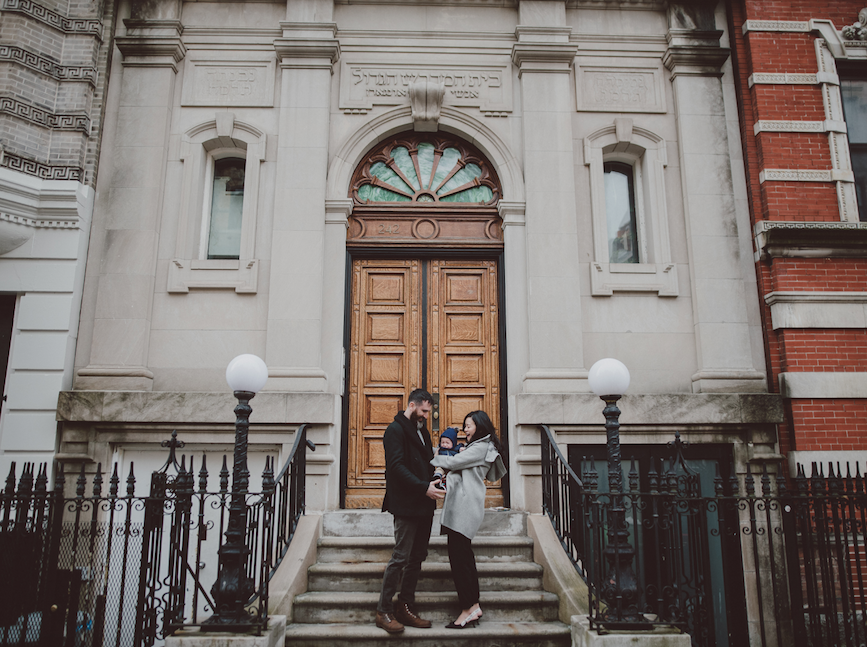
The Trencher family outside their home in a former synagogue. (Photo courtesy LOVE + WOLVES CO)
“There’s a 98 percent chance that, since my great-grandfather grew up on this block, if he wasn’t a member [of the synagogue], then at least he had been inside the building,” Trencher says. “He likely spent time there.”
Alphabet City was not on the Trenchers’ list of potential neighborhoods, but the family connection had a special appeal. Even more, Trencher says the unit was in their price range and was three times larger than other places they had been considering. Their home has 1,500 square feet of interior space and a 500-square-foot rooftop terrace.
Because of the unconventional space, it was remodeled as a triplex, with the open second floor looking out onto a living room with 18-foot ceilings. The third floor is a bedroom that leads onto the terrace.
Where ‘Cathedral Ceilings’ Is Not a Metaphor
This kind of inventive remodeling is common and necessary in former houses of worship, where developers often must create living space out of what had been a large open room with a very high ceiling.
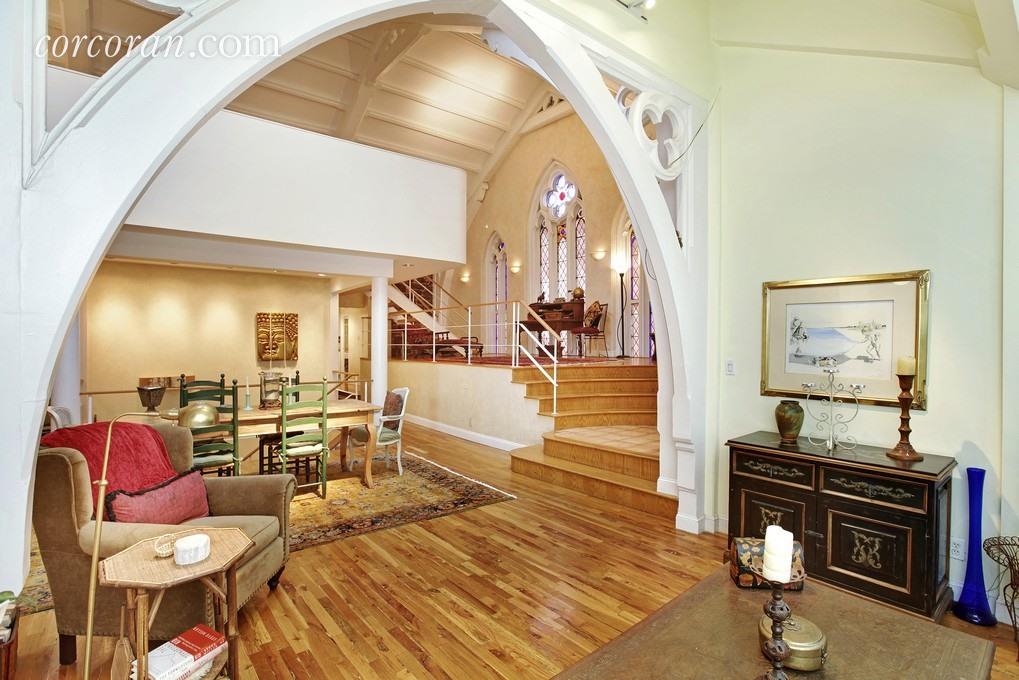
The living room of one apartment at 99 Clinton St. in Brooklyn Heights features actual cathedral ceilings.
At 99 Clinton St. in Brooklyn Heights, a former Presbyterian church built in 1850 was divided into 10 units. Apartment 9 occupies the upper part of the building, including a literal cathedral ceiling with stained-glass windows. Even with this unit raised well above the ground, the ceiling still rises 26 feet from the floor in some places.
For one of the bedrooms, the developer created a second level, but with only a railing instead of walls, so that the original ceiling and the grandeur of the space can still be enjoyed.
In a different unit of the same former church, the developer constructed a more traditional duplex, where the original space was divided into a first floor and second floor.
Restrictions on Remodeling in Historic Buildings
The Trenchers were given freedom to make their own renovations, short of touching the façade of the building. They added a bathroom to the third floor and put a washer and dryer under the stairway leading to the second floor.
But for some former houses of worship, which are often designated as historic landmarks, renovating can be more challenging, requiring permission from the New York City Landmarks Preservation Commission.
“Some people are concerned about the resale value [of a church conversion] because of the landmarked status of the buildings,” says Mathew Krem, a Douglas Elliman agent with a current listing at the Sanctuary in Fort Greene. “But [these units] have appreciated well.”
Homes that were once houses of worship might not be for everyone. But for those with an open mind and an appreciation for history, they can be a heaven.
As Trencher says, with reverence for his home’s prior purpose, “We live in a holy place.”
—
Inspired to find your next place in New York? Whether you’re looking to rent or to buy, search NYC apartments on StreetEasy.
